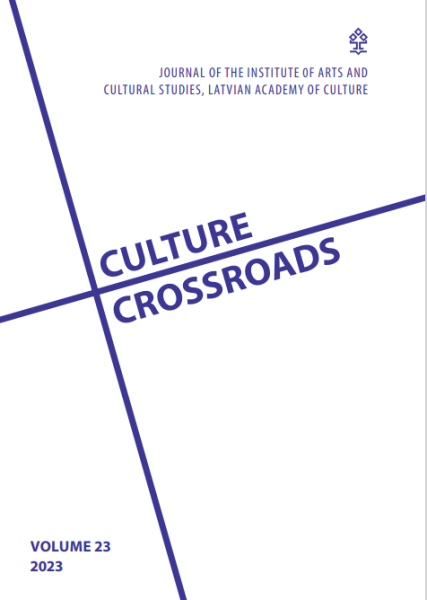METAPHORS AND METONYMIES IN LATVIAN AND ENGLISH PHRASEOLOGICAL UNITS WITH THE KEYWORD HEAD
DOI:
https://doi.org/10.55877/cc.vol23.393Keywords:
cognitive linguistics, conceptual metaphor theory, phraseology, stylisticsAbstract
Phraseology, often considered a supplementary discipline in the past, now occupies a central place in many fields as an object of interdisciplinary research for cross-cultural and cross-linguistic studies in general and cognitive linguistics, pedagogy, translation, corpus and computational linguistics, lexicography, and psychology.
Two databases in Latvian and English are used to extract phraseological units (PUs) with the keyword “head”. The article aims to identify, compare and contrast metaphorical and metonymic Latvian and English phraseological units, discussing the similarities and differences in meanings of the base form of a phraseological unit (PU) and its use in every analysed case. Since metaphor and metonymy are central thought patterns in cognitive linguistics, testing their function in PUs is crucial. Metaphorical and metonymic Latvian PUs and their English counterparts are examined in the cognitive linguistic framework, analysing conceptual metaphors and conceptual metonymies.
Corresponding pairs of PUs are studied as one set to establish if they will function similarly. It can be concluded that pairs of PUs in both languages have the same structure, convey equivalent meanings and even have the same type of conceptual metonymy: a part stands for the whole, for instance, divas galvas (ir[1]) gudrākas nekā viena (two heads (are) smarter than one) and its English counterpart: “two heads are better than one”.
Downloads
References
Aristotle ([1941 Random House] 2001). In: R. McKeon (ed). The Basic Works of Aristotle. New York: The Modern Library.
BNC – Burnard, L. (2009). British National Corpus. Faculty of Linguistics, Philology and Phonetics, University of Oxford. Available: http://www.natcorp.ox.ac.uk/ (viewed 11.01.2023.)
Corpas Pastor, G., and Colson, J.-P. (eds). (2020). Computational Phraseology. Amsterdam; Philadelphia: John Benjamins Publishing Company.
Dictionary.com (2023). LLC. Random House Unabridged Dictionary, American Heritage and Harper Collins. Available: https://www.dictionary.com/ (viewed 03.03.2023.)
Dobrovol’skij, D., and Piirainen, E. (2022). Figurative Language: Cross-Cultural and Cross-Linguistic Perspectives. 2nd edition, revised and updated. Berlin; Boston: Mouton De Gruyter.
EUROPHRAS – The European Society of Phraseology (2022). Available: http://www.europhras.org/en/europhras (viewed 29.08.2023.)
Evans, V. (2007). A Glossary of Cognitive Linguistics. Edinburgh: Edinburgh University Press.
Gibbs, R. W. Jr. ([1994] 2002). The Poetics of Mind: Figurative Thought, Language and Understanding. Cambridge: Cambridge University Press.
Gibbs, R. W. Jr. (2005). Embodiment and Cognitive Science. New York: Cambridge University Press.
Gibbs, R. W. Jr. (2017). Metaphor Wars: Conceptual Metaphors in Human Life. New York: Cambridge University Press.
Grady, J. E. (1997). Theories are buildings revisited. Cognitive Linguistics, No. 8 (4). Walter de Gruyter, p. 267–290. Available: https://doi.org/10.1515/cogl.1997.8.4.267 (viewed 28.02.2023.)
Kövecses, Z. (2002). Metaphor: A Practical Introduction. Oxford; New York: Oxford University Press.
Kövecses, Z. (2020). Extended Conceptual Metaphor Theory. Cambridge: Cambridge University Press.
Kunin, А. V. (1970). Angliyskaya frazeologiya. Teoreticheskiy kurs (English Phraseology:
A Theoretical Course). Moskva: Vysshaya shkola.
Lakoff, G., and Johnson, M. ([1980] 2003). Metaphors We Live By. With a New Afterword. Chicago; London: The University of Chicago Press.
Langlotz, A. (2006). Idiomatic Creativity: A Cognitive-linguistic Model of Idiom-representation and Idiom-variation in English. Amsterdam; Philadelphia: John Benjamins Publishing Company.
LVK2018. (2016–2018). Līdzsvarotais mūsdienu latviešu valodas tekstu korpuss. LU MII. Available: http://www.korpuss.lv/id/LVK2018 (viewed 10.12.2022.)
Mejri, S. (2004). Introduction: Polysémie et polylexicalité. Syntaxe & Sémantique, 5, pp. 13–30. Available: https://doi.org/10.3917/ss.005.0013 (viewed 27.02.2023.)
MLVV (2003–2023). Mūsdienu latviešu valodas vārdnīca. Auziņa, I., Briede, S., Kuplā, I., Lejniece, G. et al. LU Latviešu valodas institūts, LU MII Mākslīgā intelekta laboratorija. Available: https://mlvv.tezaurs.lv/ (viewed 03.02.2023.)
Naciscione, A. (2010). Stylistic Use of Phraseological Units in Discourse. Amsterdam; Philadelphia: John Benjamins Publishing Company.
Valodu portfelis (2015). Kultūras ministrija, Latviešu valodas aģentūra. Available: http://www.sazinastilts.lv/wp-content/themes/sazinas-tilts/resources/Language-Portfolio/06/L03.html (viewed 17.02.2023.)
Veinberga, E. (2014). Multimodal Metonymic Image of the Bottle in Advertising. In: E. Račienė (ed). Language in Different Contexts. Research papers, Vol VI (1), Part 1. Vilnius: Lietuvos edukologijos universiteto leidykla, pp. 182–191.
VPSV – Valodniecības pamatterminu skaidrojošā vārdnīca. (2007). Skujiņa, V., et al. Rīga: LU Latviešu valodas institūts.
Wray, A. (2002). Formulaic Language and the Lexicon. Cambridge: Cambridge University Press.
Downloads
Published
Issue
Section
License
Copyright (c) 2023 Culture Crossroads

This work is licensed under a Creative Commons Attribution 4.0 International License.


